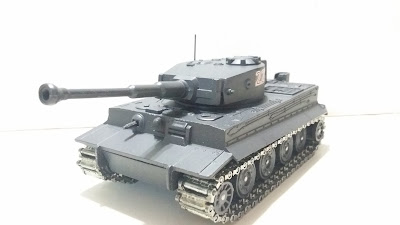(I mean that in good fun, nothing insulting intended)
 |
| As I have no pictures yet, here'one from an old blog post when I first got my Solido Tiger I. |
Please note, I haven't tried the following yet, but I plan to.
One feature I like very much in OHSW is that you don't know how long vehicles will survive - they take cumulative damage and compare that to card draws, so they can go down on one hit or last quite awhile.
If the game is small-squad infantry focused, any more detail probably isn't warranted, but in an all-tank game, some kind of effect from each hit could make it more interesting by creating some more friction.
In Disposable Heroes/Coffin for Seven Brothers (1st ed) (DHC7B), damage location is randomly determined by a ten-sided die. Different locations have different effects, also determined by a ten-sided die. In OHSW, it seems like we could do the same thing with a draw of a card. While it's possible in DHC7B to have a different percentage chance of hit location by vehicle, I've opted to forgo that possibility (a quick glance in the 1st ed core rulebook, shows the included tanks all have the same chances for location).
Also, although some of the effects result in instant destruction of the tank, that is already handled by the OHSW rules, so instead, I plan to put focus on the immobilizing and half speed effects, and killing of the hull or turret crews (loss of movement and fire respectively, maybe not entirely realistic as crew could move around if necessary I suppose)
Here, is a rough translation of the DHC7B results into card draws (I consolidated their two separate hull locations):
Damage location:
- Treads: A - 3
- Hull: 4- 9
- Turret: 10, J, Q, K
Results:
- Turret: J, K, Q - Turret damaged / crew killed, no firing (You could probably split this to have no firing vs. no turret rotation)
- Hull (upper/lower): J, K, Q - Hull crew killed, no movement
- Treads: 10-J axle damaged, 1/2 movement | Q-K thrown track, immobilized
Honestly, I think between the rules in OHSW and the above, I have enough to try it out.
 |
| Another picture from an old post featuring armor. |



I'm glad to see I'm not the only one to consider a tank vs tank game for OHSW. My reservation is that the number os active pieces would be lower than in an infantry game, which would make activation easier for an individual vehicle. You get 1-13 'PIPs' each turn, which is a stretch if you have twelve infantry figures, but less taxing for just six tanks.
ReplyDeleteThank you for the comment Kaptain Kobold! Activation is definitely easier for an individual vehicle - although it didn't turn out to be a problem in the first armour-only game I played; it seemed I never had quite enough points to do everything even if I could afford to activate each tank (I also drew low cards more than a few times which kept me from activating all tanks on a given side more than once). Tank combat has the "advantage" of chewing up cards faster than infantry - one draw for the initial attack and one for the penetration effect, and then possibly for the immediate crew morale check, so an increased chance of using up those high cards in non-activation draws. Plus, the cost of a move to turn in place in order to change the direction faced can increase movement costs if the vehicles have to maneuver much.
DeleteYour comment has me thinking though that some house rules could deal with the potential excess of PIPs in a way not so reliant on luck of the draw. To really eat up points for small tank battles (tank or otherwise), it might be worth charging more for second and third moves - to keep the balance of choice between move slow-but-many or few-but-fast. For tanks, charging more for movement off-road (by reducing distance or increasing the cost per move) may be an option - but I suppose if wheeled vehicles are in play, the balance must be struck to still give the tanks advantage off-road. Including obstacles/terrain that tanks can cross but either have to beat in some way that requires special card draws that cost moves (like in the Plan Tortue scenario) or requires extra movement beyond the first be spent could also eat up points. I can imagine urban scenarios where there is an extra cost of some kind to advance over/through walls and rubble, for example. Thanks again!
Oh! Adding a spotting/acquisition challenge for a point, or movement cost, might be interesting too.
Delete